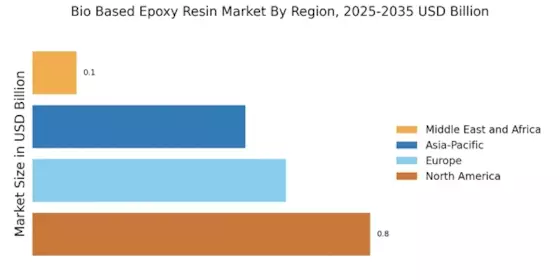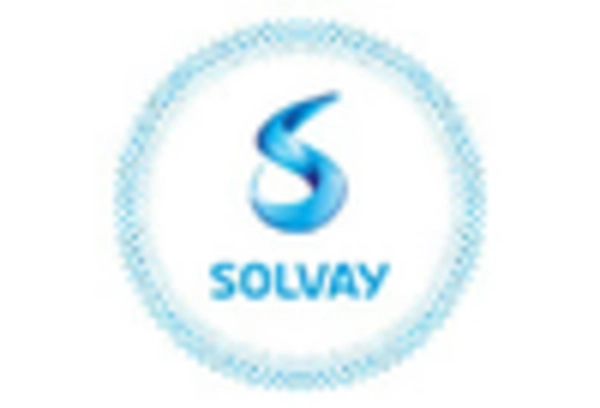Regulatory Support
Regulatory support plays a crucial role in shaping the Bio Based Epoxy Resin Market. Governments worldwide are implementing stringent regulations aimed at reducing the environmental impact of traditional petrochemical products. Policies promoting the use of renewable materials are encouraging manufacturers to invest in bio-based alternatives. For example, initiatives such as the European Union's Green Deal and various national policies incentivize the adoption of sustainable materials, including bio-based epoxy resins. This regulatory landscape is fostering a favorable environment for market growth, as companies seek to comply with environmental standards while meeting consumer demand for sustainable products. The bio-based epoxy resin market is expected to benefit from these regulations, with projections indicating a potential market size of USD 2 billion by 2028. This support not only drives innovation but also enhances the overall competitiveness of the Bio Based Epoxy Resin Market.
Technological Innovations
Technological innovations are significantly influencing the Bio Based Epoxy Resin Market. Advances in processing techniques and formulation chemistry have led to the development of high-performance bio-based epoxy resins that meet stringent industry standards. For instance, the introduction of new catalysts and curing agents has improved the mechanical properties and thermal stability of these resins, making them suitable for demanding applications. The market is witnessing a surge in research and development activities aimed at enhancing the performance characteristics of bio-based resins. According to recent estimates, the bio-based epoxy resin segment is expected to grow at a CAGR of 8% from 2025 to 2030. This growth is indicative of the industry's commitment to innovation, which not only enhances product offerings but also drives the adoption of bio-based materials across various sectors, including aerospace, electronics, and construction.
Sustainability Initiatives
The increasing emphasis on sustainability initiatives is a pivotal driver for the Bio Based Epoxy Resin Market. As industries strive to reduce their carbon footprints, bio-based materials are gaining traction due to their renewable origins. This shift is reflected in the growing demand for eco-friendly products, with the bio-based epoxy resin market projected to reach USD 1.5 billion by 2026. Companies are increasingly adopting bio-based resins to align with consumer preferences for sustainable products, thereby enhancing their market competitiveness. Furthermore, the integration of bio-based epoxy resins in various applications, such as automotive and construction, underscores their potential to replace traditional petroleum-based resins, which are often criticized for their environmental impact. This trend indicates a broader movement towards sustainable manufacturing practices, positioning the Bio Based Epoxy Resin Market as a key player in the transition to greener alternatives.
Expansion in End-Use Industries
The expansion in end-use industries is driving the growth of the Bio Based Epoxy Resin Market. Sectors such as automotive, construction, and electronics are increasingly adopting bio-based epoxy resins due to their superior performance characteristics and environmental benefits. For instance, the automotive industry is leveraging bio-based resins for lightweight components, which contribute to fuel efficiency and reduced emissions. Additionally, the construction sector is utilizing these resins in adhesives and coatings, enhancing durability while minimizing environmental impact. The market is projected to witness a compound annual growth rate of 7% through 2030, driven by the increasing penetration of bio-based materials in various applications. This expansion underscores the versatility and adaptability of bio-based epoxy resins, positioning the Bio Based Epoxy Resin Market for sustained growth in the coming years.
Consumer Demand for Eco-Friendly Products
The rising consumer demand for eco-friendly products is a significant driver for the Bio Based Epoxy Resin Market. As awareness of environmental issues grows, consumers are increasingly seeking products that align with their values, particularly in sectors such as construction, automotive, and consumer goods. This shift in consumer behavior is prompting manufacturers to explore bio-based alternatives to traditional materials. Market Research Future indicates that approximately 60% of consumers are willing to pay a premium for sustainable products, which is influencing companies to incorporate bio-based epoxy resins into their offerings. This trend not only reflects changing consumer preferences but also highlights the potential for growth within the Bio Based Epoxy Resin Market, as businesses adapt to meet the evolving demands of environmentally conscious consumers.


















Leave a Comment